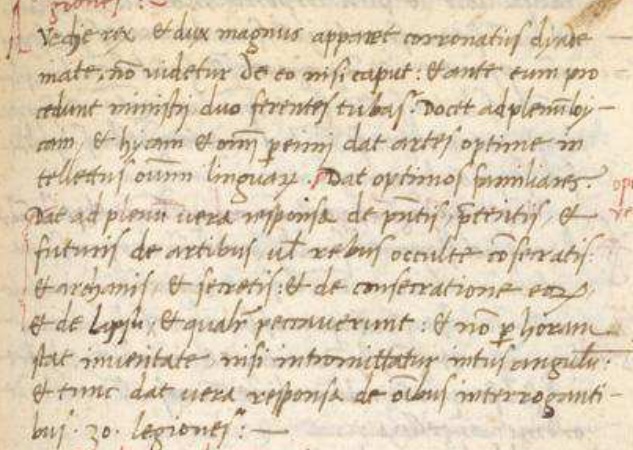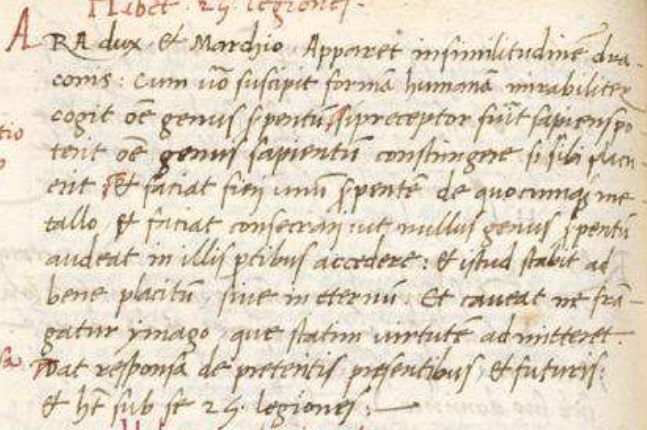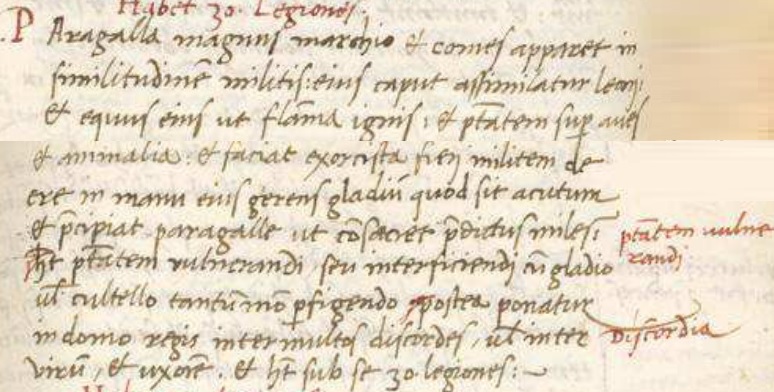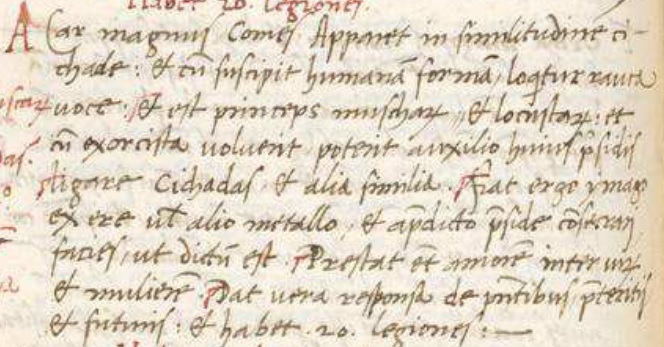Content Warning: Flashing Lights, Extreme Cheesiness:
Got some more demons to ponder. I was able to work out a lot on some of them, less on others, but mostly I just need to fill in a few gaps. Some of these are more interesting than others.

The first boy in the book, “King Avedje, a great duke appearing crowned with a diadem, there is nothing visible of him but his head, and before him proceed two ministers carrying trumpets. (I love that trumpets are tubas in this BS.) Teaches fully logic and (hycam?) and all (pereimi?) gives best arts, best understanding of all languages. Gives best familiars. Gives full true responses of past present future, arts or things occult consecrated and arcane, and secrets. (gibberish coming…) And of consecration them of the (Lupyh?), let him be then forced into a corner, and then gives true responses without being asked, 30 legions.”
I think I confirmed this guy for appearing in The Book of Oberon under the name “Ebeyeth,” where he is also described as a floating head crowned with a diadem, but the rest of the description there is too short, leaves too much out to be of much use.

This one man… no fucking idea. Trying to implement what I can learn from cartomancer in the comments:
“Ara dux et marchio Apparet insimilitudine draconis : cum nomine suscipit formam humanam mirabiliter cogit omne genus serpentum si preceptor fuit sapiens potent omne genus sapientum constringere si fili plaenerit et faciat fieri imum serpentem de quoruma?? metallo et faciat consecrari : ut nullus genus serpentum audeat in illis pribus accedere : et istud stabit ad bene placitum sine in eternum . et caveat me frangatur imago que statim virtutem admitteret . Dat responsa de pretentis presentibus et futuris : et habet sub se 29 legions.”
My best effort to make sense of that: “Ara, duke and marquis, appears in the likeness of a dragon. When assuming the form called human, has marvelous knowledge of all types of snakes, if the teacher is able to be wise, all kinds of wisdom contained. If son (plaenerit?) and makes it one snake of (quorumas?) metals and makes hallowed, that no kind of snake dare to approach them first, and this rule does not stand well forever. And should I break the image, then power is allowed. Gives responses of past present and future, has under him 29 legions.”
Hilariously, depending on what word it’s next to in google translate, “serpentum” becomes “florida.” There is no demon that appears in the form of a dragon and has this snake-obsessed of a description in the sources I’ve read. Volach has the snake control and rides a dragon, but has a separate entry in this book and is otherwise fairly different. Most demons appearing in the form of a dragon are more elaborately described, with multiple heads and what have you.

“Paragalla – great marquis and count – appears in the likeness of a knight, head like a lion, riding on a fiery flame. Controls (carries over?) birds and animals and makes the exorcist knights of copper in hand carrying sword that is sharp, and show himself Paragalle and (consacrer?) aforementioned knight. ( worse gibberish coming) Has carrying wounds or (interfiriendi?) with sword or knife only (mom? mon?) be fixed later placed in kings house, between many discords or between husband and wife. Has under him 30 legions.”
There are a few lion-headed knights in demonologies: Boab and Saylmon from this book, Allocer Sabnach and Purson/Curson from the Pseudomonarchia Demonum and related books… And that’s not including demons that are just lions, or lions with wings, or lions with snake tails or duck feet or whatever. I think these writers imaginations were broken. Anyway, none quite match the description of Paragalla here.

This is my favorite for one weird detail. I think he appears in the form of a cicada, which is unusual and interesting. That word looks like “cichade,” and later “cichadas” appears. Latin for cicada is “cicada,” Italian is “cicala.” This isn’t quite either of those and I could be dead wrong, but what else can it be? My best translation: “Great count Acar appears in the likeness of a cicada, and then in human form speaks with a rough voice, and is the prince of flies and locusts, and per the exorcist powerfully help people control and bind cicadas and other similar things. Let there be, therefore, an image from copper or other metals, of aforementioned president consecrated. Provides love between men and women, gives true responses of past present and future, has 20 legions.”

1. Avedje, rex et dux magnus, apparet coronatis diademate,
non videtur de eo nisi caput: et ante eum
procedunt ministri duo ferentes tubas. Docet at plenum
loyicam et hyicam et omnes pere(g)rini dat artes optime
intellectus omnium linguarum. Dat optimos familiares.
Dat ad plenum vera response de praesentis, praeteritis et
futuris de artibus ut rebus occulte consecratis
at archanis et secretis et de consecratione eorum
et de lapsu et qualiter peccaverunt. et non per hoc
mi(ni)st(r)at in veritate nisi intromittatur inus angulum
et tunc dat vera responsa de omnibus interrogantbus.
30 legiones.
Avedje, a king and great duke, appears crowned with a diadem.
He is not seen apart from his head, and before him
proceed two attendants carrying trumpets. He teaches to the
fullest extent logic (in both of its disciplines*) and gives all the exotic arts,
understanding all languages very well. He gives the best familiars.
He gives to the fullest extent true responses about the present, past
and future, about the arts or matters consecrated to the occult,
and matters arcane, and secrets and their consecration and on the Fall
and how they have sinned: and he does not deal in truth in this
unless put in a corner – then he gives true responses to all questions.
30 legions.
*”hyica” is basically a synonym for “logica”, used occasionally by scholastic writers of the 11th-15th Centuries. Whether this writer understands any specific distinction between the two terms that earlier writers did not is unclear.
2. Ara, dux et marchio, apparet in similitudine draconis.
cum nobis suscipit formam humanam mirabiliter cogit omnes
genus serpentum. si preceptor fuit sapiens poterit omnes genus sapientum constringere
si sibi placuerit et faciat fieri imum serpentem de quorum qui metallo
et faciat consecrari ut nullus genus serpentum audeat in illis praesentibus accidere:
et istud stabit ad bene placitum sine in eternum et caveat ne frangatur
ymago que statim virtutem admitteret. Dat responsa de praeteritis, praesentibus
et futuris et habet sub se 29 legiones.
Ara, duke and marquis, appears in the likeness of a dragon, When he takes on
human form for us he can miraculously compel all types of snakes.
If the summoner were wise he would be able to encompass all kinds of wisdom
if it pleased him, and make snakes lower themselves to the ground.
On this matter, he who (takes) metal*, and has it consecrated so that no type of snake dares to come into that
place, will stand well pleased, though not forever, and should fear
lest the image is broken, and immediately lets the qualities in.
He gives responses about the past, present and future and has under him 29 legions.
*metallum can mean metal, but it can also mean a mine where metal is dug up. So we might be using metal to make a talisman here, or warding off a mine from invasion by snakes. The peculiar use of the genitive rather than the dative with de here is ungrammatical, but something of the sense comes across well enough in context.
3. Paragalla magnus marchio et comes apparet in
similitudine militis: eius caput assimilatur leoni
et equus eius ut flamma ignis et potestatem super aves
et animalia (habet). et faciat exorcista fieri militem de
(a)ere in manu eius gerens gladium quod sit acutum
et praecipiat paragalle ut consacrer praedictus miles:
habet potestatem vulnerandi seu interficiendi cum gladio
ut cultello tantummodo perfigendo postea ponatur
in domo regis inter multos discordes ut inter
virum et uxore. Et habet sub se 30 legiones.
Paragalla, a great marquis and count, appears in
the likeness of a soldier. His head is likened to a lion
and his horse is as a flame of fire, and he (has) power over
birds and animals. And let the exorcist make it so that there
is a soldier of bronze, carrying a sword in his hand, and let it
be sharp. And let him command Paragalla to consecrate the
aforementioned soldier: it has power to wound or to kill
with a sword, or merely with a knife, by piercing. Afterwards
it is placed in the house of the king, amid many quarrels, such
as between man and wife. And he has beneath him 30 legions.
4. Acax, magnus comes, apparet in similitudine
cichade: et cum suscipit humanam formam loquitur rauca
voca: et est princeps muschorum et locustarum: et
cum exorcista voluerit poterit auxilio huius praesidis
ligare cichadas et alia similia, fiat ergo imago
ex (a)ere ut alio metallo, et apraedicto praeside consecrari
facies ut dictum est. Praestat etiam amorem inter virum
et mulierem. Dat vera responsa de praesentibus, praeteritis
et futuris et habet 20 legiones.
Acax, a great count, appears in the likeness of a
cicada. And when he takes up human form he speaks in a harsh
voice, and is the prince of flies and locusts. And
when the exorcist might wish to, he will be able, with the aid of this reigning power,
to bind cicadas and other similar things. Let there be, therefore,
an image of bronze or another metal, and let a face be
consecrated to the aforementioned power, as was said. He
will even offer love between a man and a woman. He gives
true responses on the present, past and future, and has 20 legions.
As for the spelling of cichada, it is very common in Medieval and later Latin to start spelling words with a ch where Classical Latin used only a c (or sometimes only an h – “nichil” for “nihil” for example). This was due to changing pronunciations, and can be seen as a natural part of the transformation of Latin into the numerous Romance languages. Think of how we pronounce “cello” for instance (chell-oh, not sell-oh): in a time before arbitrary spelling conventions were a thing it would occur to most people to spell it as it sounded.
Still hard to get a sense of meaning from parts of Ara’s description, even with the translation clarified, isn’t it? But thanks a lot! This is indispensable. Also nice to have the cicada thing confirmed, and a head’s up about extraneous Hs I might run into going forward.
–